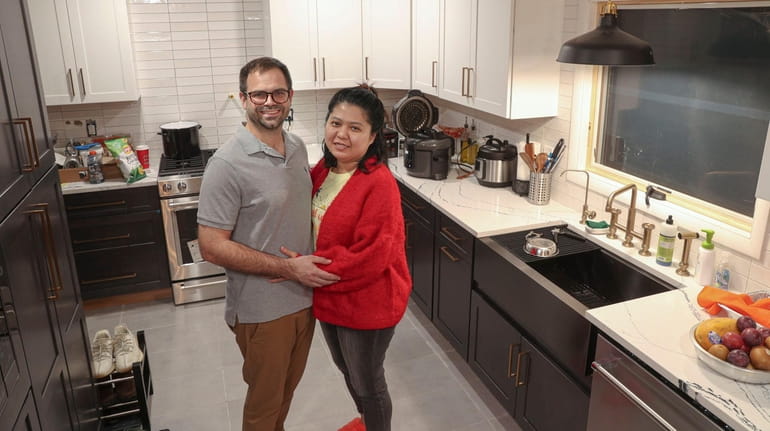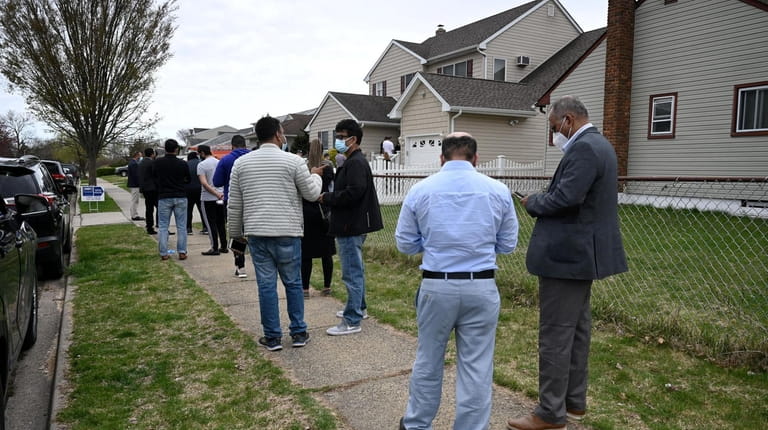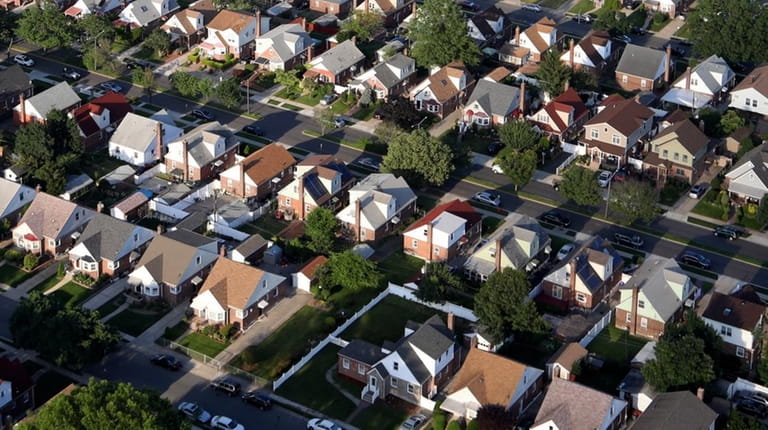Fast-paced Long Island housing market depletes inventory of homes for sale

Matt and Khine Kaplowitz put in offers on 11 houses before finally landing their South Huntington home. Credit: Newsday/John Paraskevas
Khine and Matt Kaplowitz knew it would be challenging to buy a home on Long Island but they weren’t prepared for just how crowded the market would be with buyers.
The couple was living in a one-bedroom apartment they owned in Jamaica, Queens, last winter when political turmoil in Khine’s native Myanmar sped up their search. The military in Myanmar seized control of the government Feb. 1, and Khine’s parents, sister and brother-in-law fled the country for the U.S.
"We were not rushing to buy because we knew that the market was really hot, but that happened ... so we needed a place in a rush," Khine Kaplowitz said.
The Kaplowitzes, who are both 33, started their search in February at a time when Long Island had the smallest number of homes on the market since 2003, the year appraisal firm Miller Samuel started collecting data on the Island’s inventory. While high prices have drawn sellers to list their homes, buyers have snapped them up at a record pace, with bidders driving sales above sellers’ asking prices.
The couple didn’t anticipate just how much competition they would face. They set out to tour five to six homes each Saturday and Sunday and found lines out the door. They were regularly torn between waiting on an open house or finding another with a shorter queue. The couple soon split with their real estate agent after they disagreed when he wanted them to sign a contract despite issues with one house that were discovered during an inspection.
"After putting in two, maybe three, offers that didn’t go through, he basically fired us," Khine Kaplowitz said.
The couple estimate they looked at between 150 and 200 houses over three to four months. They put in 11 offers and seven were accepted, but several deals fell through because of issues with current tenants or because the homes showed serious flaws upon inspection. They finally landed a five-bedroom, three-bathroom home in South Huntington for $620,000, which they closed on in August. The house has needed about $80,000 of work to renovate flooring, the kitchen and a bathroom.
"We thought this place had more space for us," Khine Kaplowitz said.
The North Shore of Suffolk County, where the Kaplowitzes now live, has been the toughest seller’s market on the Island, according to Miller Samuel’s data. As of Sept. 30, the area had just 0.9 months’ worth of inventory for sale. That means it would take less than one month for all the available houses in that area to sell at the current pace of sales.
In a market in which buyers and sellers were on a level playing field, there would be five to six months of inventory available. The North Shore of Suffolk, which excludes the North Fork in Miller Samuel’s data, represents the most extreme case, but across the Island sales and supply data show how much the market has been tilted in favor of sellers this year.
Islandwide, excluding the Hamptons and the North Fork, there was 2.2 months of supply of condos and one- to three-family homes available to buyers as of Sept. 30. In Nassau that figure was 2.4 months’ worth. In Suffolk, excluding the Hamptons and North Fork, it was 1.9 months.
There were 6,615 homes for sale on Long Island, excluding the East End, as of Sept. 30. That was slightly above the supply’s record low of 5,532 homes, hit on March 31, at the end of the first quarter of the year. But it was 75% below the record high inventory of 26,145 homes hit during the housing bubble in June 2008.
The decline of mortgage rates has created demand so great that the market couldn’t keep up, said Jonathan Miller, CEO of appraisal firm Miller Samuel. He noted the average rate for a 30-year, fixed-rate mortgage fell by nearly half in less than two years.
In the past decade, the average mortgage rate peaked at 4.94% in November 2018 and bottomed out at 2.65% last January. The average was 3.11% for the week ending Dec. 2, according to mortgage giant Freddie Mac.
"It has added fuel to the fire," Miller said. "The demand side of the equation has overpowered inventory."
Could the resulting run-up in prices indicate a bubble and suggest a related drop in home values is to come? This market isn’t the same as during the last recession, when U.S. home prices fell by one-third, said Miller.
"People that are getting mortgages now are highly qualified. Credit conditions for banks are about 20% tighter than long-term norms," Miller said. "We’re not looking at a correction. It’s more likely we’re looking at a plateau or a moving sideways scenario."
The low supply of houses isn’t merely a product of the pandemic, as inventory levels were dwindling even before COVID.
"It is a result of a decade of underproduction of new homes in the U.S. and the cumulative effect of it was that we had an inventory shortage before the pandemic, and then when the pandemic occurred, home sales just flew off," said Lawrence Yun, chief economist at the National Association of Realtors.
Long Island has faced even tighter inventory than the rest of the country, he said.

Long Islanders have faced the lowest housing inventory level since 2003 this year. Here, prospective buyers line up outside an open house in April. Credit: Danielle Silverman
When the housing market is this tight, first-time homebuyers suffer, Yun said. First-time homebuyers represented 29% of purchasers in NAR’s October survey of Realtors. Under normal market conditions, Yun would expect first timers’ share to be one-third to 40%.
"Homeowners who want to trade up, trade down, or move into another state — they don’t have a problem because they can sell a home, get a large proceed and use that proceed as down payment, or in some cases, in all-cash transactions," Yun said. "But it really squeezes away the first-time buyers who simply don’t have the luxury of selling something."
New York’s looming Jan. 15 end to a moratorium on foreclosures could add to the number of houses for sale. But it’s unlikely to make a significant difference, as distressed sales make up only about 1% of the market right now. "Unfortunately, some will be forced sales," Yun said.
‘Nothing for sale’
Jamie Gorman, a real estate agent at Charles Rutenberg Realty in Plainview, said she’s seen listings dry up in the past three months after having plenty of homes to sell earlier this year.
"There’s literally nothing coming up for sale. I have so many buyers and there’s nothing. I can’t even show them anything," Gorman said. "If I was going to give someone advice, if they were looking to put their house up on the market, I would say do it right now, and you will have a bidding war galore."
A client of Gorman’s, Adam Goldfarb, 48, said he and his wife set out in February to move to Plainview with their 10-year-old twins from their apartment in Forest Hills. After seeing dozens of homes and putting in at least six offers, the Goldfarbs decided in July to work with a developer building a new house in Plainview. The family is now renting in Farmingdale while they wait for the home to be completed. Delays in receiving building materials have pushed their move-in date past February, and it's unclear when the house will be ready.
But Goldfarb decided the short-term inconvenience would be worth it compared to the decades he expects to spend in the new home, where he won’t have to worry about issues with the boiler or roof for years. He said he is glad to be done with a sales process that regularly had him viewing houses Saturday, putting in an offer on Sunday evening and facing a decision of whether to offer more by Monday.
"The pace by which you had to make giant life decisions was unnerving," he said.
New construction can help but doesn’t represent a sizeable enough portion of the market to significantly change the supply and demand dynamic. Sales of new homes represented just 6% of all homes sold in the Northeast in September, according to seasonally adjusted data from the National Association of Home Builders.

Since February, Matt and Khine Kaplowitz looked at more than 150 homes and made 15 offers before they found the right fit in this home in South Huntington. The couple, who were looking for a bigger home to accommodate a large extended family, are shown in the recently renovated kitchen of their new home on Wednesday, Dec. 1, 2021. Long Island housing inventory is near its lowest level since 2003 posing a massive challenge for homebuyers. Credit: Newsday/John Keating
Rachna Bhatia, an agent at Voro Real Estate in Hicksville, said she has advised buyers not to restrict themselves to certain towns if they want to buy quickly. She said there are still new listings but whatever comes up for sale goes quickly.
"For buyers who are not compromising, they are sitting on the sidelines. I have one or two who have been sitting on the sidelines for six months. If you’re choosy, you’re not getting anything," Bhatia said.
Catherine Lindstadt, an associate broker at Douglas Elliman who markets homes in communities on the North Shore of Suffolk County including East Northport, Huntington and Commack, said the volume of sales has slowed compared with last year, in part because sellers are seeing prices rise in other areas where they’d be interested in moving.
"It’s mostly deciding where they want to go. It’s a harder decision based on other markets being so vibrant," Lindstadt said.
New Yorkers interested in bolting for warmer weather have been met with steady price appreciation in some of the most popular destinations. Prices in Phoenix, Tampa and Miami rose the most in September among the 20 cities measured by the S&P CoreLogic Case-Shiller Indices. Those areas saw year-over-year increases of 33.1%, 27.7% and 25.2%, respectively.
There are some signs that demand for homes on Long Island is waning, which could slow the pace of the market and keep more listings available for a longer period. Home prices dipped over the past two months, according to data from OneKey MLS.
Yun, the economist, also expects mortgage rates to rise in 2022.
"The Federal Reserve is already hinting strongly they will be raising interest rates next year. The other part is high consumer price inflation. Even if the Federal Reserve does not make a move, the lenders on their own begin to raise interest rates to compensate for some loss in purchasing power. High inflation will push up the interest rates, so that’s going to shave off some housing demand," Yun said.
The Kaplowitzes eventually landed their home in South Huntington and were able to move in late October while renovations continued. They suspect they were picked from among multiple offers for the home because they offered a larger down payment than other prospective buyers.
The couple lost several bidding wars including one on a house around the corner that needed less work that sold for $675,000. The market led the couple to keep increasing their budget because of the competition and selection of homes that were available, Matt Kaplowitz said.
"In hindsight, if we knew we were going to end up spending so much here to renovate, we would have much rather spent that money to get that house," Matt Kaplowitz said. "At the end of the day, we ended up in a place where we’re pretty happy."
"It might not be our forever home, but it is good for us right now," Khine Kaplowitz added.

